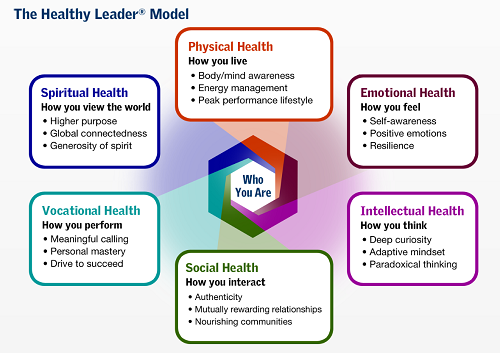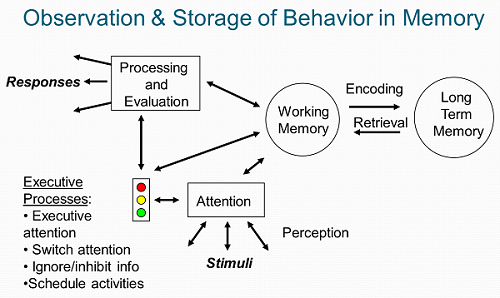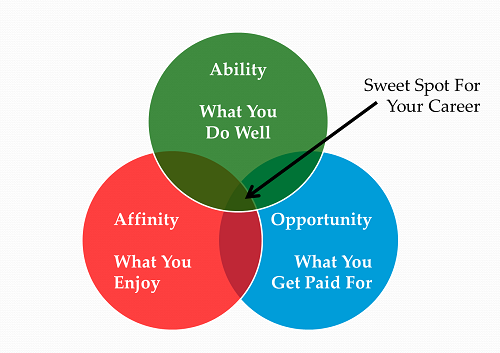When you walk in the room, who shows up for Read more →

The Roots of Healthy Leadership
Allen Slade
For sustained leadership success, you must consider more than just what you accomplish or how you act. You must consider who you are.
Bob Rosen of Healthy Companies International has been researching and writing about leadership health. He has a book coming out soon and because of the partnership between Healthy Companies and Slade & Associates, I would like to give you a sneak peak of Bob’s Healthy Leader® model. Today’s post will share some images of healthy leadership, and over the next month, we will explore the impact of healthy leadership on organizations
Leadership is like a tree. The leader’s accomplishments are the fruits of leadership. The leader’s actions are the visible parts of the tree – the trunk, branches and leaves. But the roots of leadership are defined by who the leader is. Without healthy roots, there will be no fruit and the tree will wither.
The six dimensions of leadership health – physical, emotional, intellectual, social, vocational and spiritual – define who you are as a leader. They are the roots of your leadership.
Image courtesy of Healthy Companies Inc.
Leaders who are healthy have strong roots that lead to effective leadership behavior and positive outcomes for the organization.
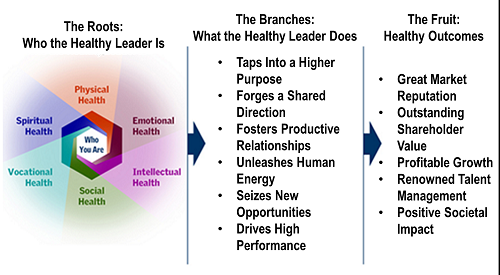 Modified from an image courtesy of Healthy Companies Inc.
Modified from an image courtesy of Healthy Companies Inc.
How healthy is your leadership? By examining the roots of your leadership, by looking at who you are and not just what you do or how much you accomplish, you can create sustainable success for yourself and those you lead.
Leading with Goals
Allen Slade
Goal setting should be one of the most useful tools in your leader’s tool box. Goals can drive intelligent dialogue about performance with your employees, leading to greater success and satisfaction for your employees and your organization. Here are some ways you can use goals to lead more effectively.
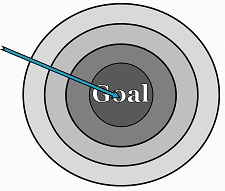 Use goals to set a benchmark for performance. A goal setting conversation should kick off the performance planning cycle – the what, when and how of performance. Help your employees set SMART goals: specific, measurable, actionable, realistic and time-bound.
Use goals to set a benchmark for performance. A goal setting conversation should kick off the performance planning cycle – the what, when and how of performance. Help your employees set SMART goals: specific, measurable, actionable, realistic and time-bound.
Engage employees fully in setting goals. Employee involvement creates more commitment to follow through. Don’t feel you have to mandate goals for your employees to prevent slacking. Research shows that most employees set challenging goals. Trust your employees. Treat goal setting as a dialogue rather than a top-down mandate. The goals that result will work well for you and your employees.
Make sure each employee has the right number of goals. Three goals will work well for many entry-level jobs. A retail sales person might have goals for sales volume, customer satisfaction and maintaining a clean sales area. A new manufacturing supervisor might have goals for production, quality and cost.
As an individual gains responsibility, the number and complexity of goals will increase. Use your goal setting conversations to lift their eyes to the new horizon. A new leader may be taking on people management for the first time. Help them set their own leadership goals. A new general manager’s goals need to be cross-functional and integrative. Help them set goals on profitability, innovation or stakeholder relations.
During the year, goals allow continuous improvement. Help your employees use data to unlock their habits. Just as you should have a leadership scorecard, encourage your employees to build a scorecard with metrics for their goals. Then, you can check in periodically to help overcome any blockades to performance.
At the end of the year, use goals to review performance. If goals have been the benchmark for performance and driver of continuous improvement through the year, the performance review should be straight forward. If an employee is not meeting their goals, you will need to manage the employee up or manage the employee out. You can focus on the required improvements, get specific about what changes are needed and (in the extreme) set a deadline for measurable improvement. However, if you lead with goals, most of your employees should be performing well. You will celebrate success together and renew the goals for next year.
Bottom line: As a leader, have a goal setting conversation with each employee at the beginning of the year. Encourage them to set SMART goals. Make sure each employee has at least three goals but not so many goals they are overwhelmed. Use their goals for continuous improvement throughout the year. And focus on performance against goals at the end of the year.
Help your employees get their goals right. If you lead with goals, your organization and your employees will benefit.
How’s Your Digital Deception Detector?
Allen Slade
Catfishing entices a dupe to befriend a fake person, to the victim’s embarrassment. Notre Dame football player Manti Te’o used his girlfriend’s death to propel his team to the national championship game. When this girlfriend turned out to not exist, he claims to have been duped.
Was Manti Te’o a victim, part of the scheme or a little of both? How could credible sports reporters feature this emotional story without checking their facts?
Leaders must be masters of the digital divide that catfishing exploits.
The PC generation sees technology as a tool. They master new technology as necessary to get things done. They tend not to be early advocates of new technology. They would rather not upgrade Windows or switch from email to Facebook unless there is a good reason. They want a tested version of the new technology, with no bugs and a good help function.
The Net generation integrates technology fully with relationship. They may be early adopters of new technology, but they adopt it for coolness as much as utility. Their choice of media is driven by relationships. They use Facebook (or Twitter or Pinterest or whatever) because many of their friends do. And, their use of a network creates more friends on that network.
One of the differences between these generations is how they avoid deception in digital relationships – the problem of Manti Te’o’s nonexistent girlfriend. The PC gen avoids deception by limiting true relationships to people they have met face-to-face. They might think Manti is a fool for having a girlfriend he never met. The Net gen does not limit friendships to the physical world. Instead, they survive and thrive in the virtual world by developing finely tuned deception detectors. They might think Manti Te’o is a fool because his digital deception detector failed.
The PC gen and the Net gen can be hard to tell apart. They both use smart phones and tablets, Facebook and Twitter, Excel and WordPress. And, a 70-year old can be in the Net gen while her grandson is in the PC gen. Manti may be a Net Gen’er who duped PC Gen sports reporters until things spun out of control. Or he may be a PC gen’er whose use of network technology was naïve.
As a change leader, how can you tell them apart? I ask a single question: “Do you have close personal friends that you have never met face-to-face?”
- PC gen: “Are you kidding?”
- Net gen: “Yes”, with active digital deception detector.
- Future catfishing victim: “Yes” but lazy or clueless about digital deception.
As a leader, you must navigate the digital divide between the PC generation and the Net generation with agility and authenticity.
If you are of the PC generation, master the new technology and find friends you will never meet face-to-face. Go slowly to avoid being catfished. Don’t propose marriage but do corraborate any funeral notice. (You can practice with me – Twitter, Facebook and LinkedIn buttons are at the top of this page.)
If you are of the Net generation, bring the PC generation along by appealing to the utility of the networked world. Help them avoid being catfished. Appreciate and honor their desire for face-to-face contact.
Whichever side of the divide is your native land, mediate the conflicting world views with authenticity. Then, you will be able to get everybody on board with your larger purpose.
Unlock Your Habits With Data
Allen Slade
Leaders are creatures of habit. We hit upon a successful approach to communication, planning, decision making or hiring and we stick with it. Habitual behavior is very sensible. What worked yesterday is likely to work today. Yet, habits can become handcuffs. Habits may be comfortable and easy, but disaster looms around the corner.
As a leader, how do you know when to change? How do you unlock your habit handcuffs? You need data.
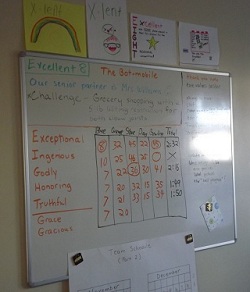 In the FIRST Lego League robotics competition, my sons’ team collected lots of data. They programed a wheeled robot to run a mission in 2 minutes and 30 seconds. The team spent months strategizing and reprogramming to beat the time limit. Data on the robot’s speed and reliability were key to continuous improvement.
In the FIRST Lego League robotics competition, my sons’ team collected lots of data. They programed a wheeled robot to run a mission in 2 minutes and 30 seconds. The team spent months strategizing and reprogramming to beat the time limit. Data on the robot’s speed and reliability were key to continuous improvement.
As a leader, you need data to know when your habits are ineffective. I advise you to build your own leadership scorecard. Track data on at least four different outcomes. Use a mix of “soft” data (employee and customer satisfaction, 360 data) and “hard” data (sales, costs, productivity and quality). If your organization produces reports for you, I encourage you to create your own leadership scorecard. If your organization doesn’t generate the data you need or if you are an entrepreneur, you may need to collect the data first.
You need to track these outcomes over time. Data from one point in time does not drive action nearly as well as trend data.
Once you have the data, build a spreadsheet or put it on a whiteboard. Avoid data overload by keeping your leadership scorecard focused. It should fit on a single sheet of paper or part of your whiteboard.
Once your scorecard is built, you are ready to start the cycle of intelligent change.
When your habits are not working, your scorecard will show it. Engage your team or your circle of trusted advisors in dialogue. Analyze the data and interpret the causes. Plan actions to fill the gaps and follow through. Then collect more data.
Bottom line: Leaders need to be data-driven. Create your own leadership scorecard to unlock the handcuffs of habit and reprogram your own behavior.
Create a virtuous cycle of intelligent change. Don’t wait for a crisis to look for numbers. Being data-driven should be your new habit.
The Problem with Your Personal Brand
Allen Slade
When you walk through the door, who shows up for the other people in the room? What image do people have of you? When I walk in, I would like to think that the “real” me shows up. Unfortunately, who actually shows up is an imperfect memory of me. Here’s a picture of the cognitive process of what people remember about you:
Bottom line: The problem with your personal brand is every step of cognition simplifies and distorts the memory of who you are. As Leonardo DiCaprio’s character in the movie Inception says: “But I can’t imagine you with all your complexity, all your perfection, all your imperfection.”
If only a partial image of the “real” you shows up when you walk in the room, you need a brand and a plan. You need a personal brand statement like this:
For [a specific person or group], I want to be known for [six adjectives] so I can deliver [valuable outcomes].
For example, here is part of my own personal brand statement:
For my leadership coaching clients, I bring powerful listening, insightful curiosity and straightforward knowledge to create maximum leadership presence, personal effectiveness and organizational success.
Here are some suggestions on how to craft your own personal brand statement:
Target your brand. You should have a targeted personal brand statement for each group or person you want to impact. For myself, I have three brand statements. You need at least two brand statements.
Be organized. Gather all the data about how others perceive you – performance reviews, personality profiles, 360 feedback, key emails, verbal impressions, etc. Then take at least four hours spread over several days to draft your personal brand statement. Here is a personal brand worksheet to help you get started on defining your own personal brand statement.
Be authentic. Make sure your personal brand is completely compatible with the real you. Being authentic moves your personal brand from false advertising to true marketing. If your personal brand promises what you can actually deliver, you and the people you serve will be happier.
Get feedback. Once you have a draft of your personal brand statement, share it with your circle of trusted advisors. Their reaction to your brand can help you test its authenticity and its value to the people you want to serve. Your circle of trusted advisors should include mentors, spiritual advisors and, ideally, a certified career coach, leadership coach or executive coach.
When you craft a personal brand statement, you help focus the impressions others hold about you. You open doors to new leadership and career opportunities. Then, when you walk in the room, “who shows up” for the other people is the authentically influential you.
What to Expect from Career Coaching
Allen Slade
How can you find your dream job? Professional golfers, Olympic athletes and leaders all use coaches to maximize their performance. To accelerate your career success, consider adding a career coach to your search strategy.
Work takes up half your waking hours. If work is not going well – a toxic boss, a dead-end job, unemployment or underemployment – life tends to follow. In a booming labor market, new jobs are low hanging fruit. But in our current economy, you need a ladder to pick the apples at the top of the tree. You need a career coach.
A career coach is more effective than a teacher or mentor at stretching you to your best self. Your coach assumes you are the expert on your own career. Your coach will help you create a career plan and pursue opportunities effectively. And, a career coach will help you hold yourself accountable for meeting your career goals.
With my clients, we usually start with the ability, affinity and opportunity that make up their dream job.
Balancing ability, affinity and opportunity leads to long-term career success. If you focus on getting the highest paying job by matching your abilities with your opportunities and you ignore what you enjoy, you could end up in a dull job. If your focus on doing what you enjoy and do well, you could end up chasing disappearing opportunities with low pay, such as in the newspaper industry. If you focus only on high paying jobs you would enjoy, but you don’t have the required ability, you will never get a job offer.
A career coach will help you balance ability, affinity and opportunity. Coaches treat you as the expert in your own career, so they won’t direct you down a path you don’t like. They will help you find your own way. Coaches also have the ability to give gentle but powerful feedback on your plans. If you wish to pursue a new field, a good career coach will help you test your plans more gently than Monty Python’s vocational guidance counselor.
When you have identified your career direction, your coach will help fill your career pipeline. Your coach helps you expand your network, generate job leads, polish your resume/LinkedIn profile, target your applications, refine your interviewing skills and make the best decisions on job offers.
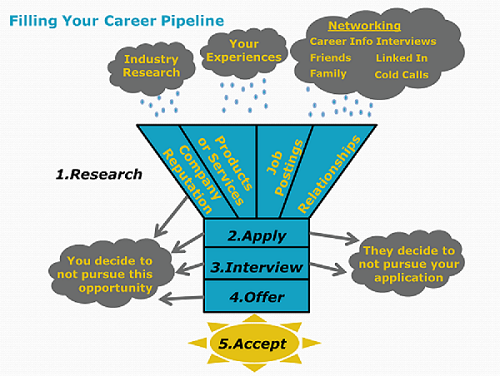 Like any professional service, fees for career coaching can be an issue. The payoff from career coaching is immense. It leads to higher satisfaction, more fulfillment and more pay. If you can afford career coaching, you will find it a worthwhile investment.
Like any professional service, fees for career coaching can be an issue. The payoff from career coaching is immense. It leads to higher satisfaction, more fulfillment and more pay. If you can afford career coaching, you will find it a worthwhile investment.
What if you can’t afford career coaching? If you are a recent college graduate, I recommend using your alma mater’s career center. If you are leaving a company, negotiate for career coaching as part of your outplacement package. You can also check to see what career development services are available from your state or local government.
Whatever you do, don’t settle. Don’t resign yourself to a dead-end job or unemployment. Don’t tolerate a poisonous work situation. Don’t say yes to an unattractive job offer. Pursue your dream job with the dedication of an Olympic hopeful. Fine tune your search skills like a professional golfer on the driving range. And, invest time and money to get the best career coaching you can get.
What to Expect from Leadership Coaching
Allen Slade
Gifts can be a source of joy or a nasty surprise. If your company provides you a leadership coach, how should you react? Heartfelt delight or muted disappointment? Is leadership coaching the perfect gift for you? Or is it the ugly sweater?
Leadership coaching is a powerful gift when it works as designed. Coaching increases your ability to achieve results and build healthy relationships. It helps you stretch into your best self as a leader.
A talented and wise coach (preferably accredited) will help you stretch into your best self. The coaching conversation can be the high point of your week. Your coach’s insightful listening and powerful questions can trigger new insights into your leadership. The best coaches assume that you are the expert on your own situation. Your coach will draw out your expertise through inquiry, curiosity and gentle challenges. The mini-experiments you design together can lead to breakthroughs in your influence and your presence as a leader.
Leadership coaching comes in different flavors:
Coaching for achievement maximizes your performance in your current role. The leader wants to move from good to great. Your leadership coach will help you focus on the behaviors and thinking necessary to supercharge performance. For achievement coaching to have maximum value, you need to have already learned the ropes. That means 6 months or more in your current job.
Coaching in transition helps you adjust to a new role so you can have a fast start. Your coach will help you learn the ropes – making sense of your new role. Rapid sense-making will help you adjust your behavior, thinking and expectations to accelerate maximum performance in your new role. Transition coaching may start before, during, or soon after the leader has moved into a new role. Sometimes, recruiting firms will provide a leadership coach to ensure that the placement has the greatest odds of success.
Coaching in crisis is designed to turn around an unsuccessful situation. The leader’s performance is unacceptable in one or more ways, and the leader and the organization want to improve the situation. Successful crisis coaching requires the leader, HR and the leader’s manager to agree to have mutual candor, commitment to change and the expectation that things can improve.
When can the gift of coaching turn out to be an ugly sweater? One example is coaching in crisis when the organization has already decided to end the leader’s employment. Another example is when the leader’s confidentiality is violated.
Most ICF accredited coaches take steps to avoid these situations. If no turnaround is possible, Slade & Associates does not offer coaching in crisis. (However, if the leader’s employment is at an end, we gladly offer career coaching as part of outplacement packages.) We always require a written agreement of strict confidentiality. Our approach to leadership coaching safeguards our dialogue, maximizes your insight and drives intelligent change for your organization.

Leadership coaching is an incredible benefit. If your organization offers you a leadership coach, accept the gift gladly. Check on the coach’s credentials. Make sure your coach, your organization and you agree on the purpose of the coaching. Demand coaching confidentiality. Then, prepare to be surprised and delighted as you unwrap the insights and wisdom of leadership coaching.
Feedback Should be “Just Right”
Allen Slade
A careful reading of Goldilocks and the Three Bears suggests three lessons for leaders: Moderation in all things. Don’t be impulsive. Breaking & entering causes problems, especially at the Bears.
Previous posts have looked at The Problem with Feedback and Different Perspectives on Feedback. Today, we will consider moderation in two aspects of feedback. Instead of a single feedback cycle that may be too hot or too cold, just right feedback requires that you mix the timing of your feedback cycles. And, don’t just impulsively act on feedback. Use insight and analysis to balance openness to feedback with constancy of purpose.
Multiple Feedback Cycles
As a leader, you should be open to feedback because you need to know “When I walk in the room, who shows up for the other people?” You need to seek out feedback relentlessly. 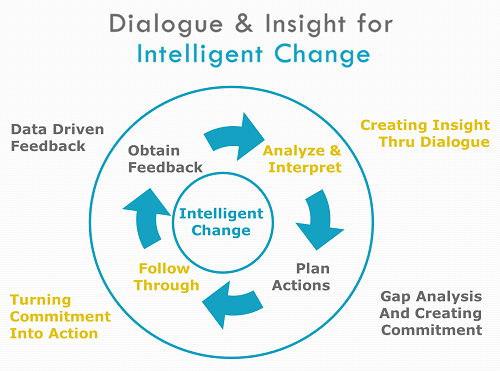
But it is not enough to collect feedback tidbits. To drive intelligent change, you must analyze and interpret the feedback you receive. You must plan actions based on the feedback. You must follow through with your plans. Then, you must start the cycle again by collecting more feedback. If things are going well, continue on. If your feedback suggest things are not going well, change something – your follow through, your action plan or your analysis and interpretation of the feedback. This feedback cycle drives intelligent change.
How long should your cycle take? Consider feedback cycles of three lengths:
Long-cycle feedback. This is feedback on long term impact, such as data from the annual employee opinion survey or a 360 report. Long-cycle feedback looks at the sum of your actions over a period of time. Long-cycle feedback is typically generated by the organization with safeguards to increase its validity (e.g., anonymity) and relevance to organizational leadership (e.g., a competency model). Yet long-cycle feedback by itself is not enough to develop your leadership. The assessments underlying long cycle feedback are complex and open to rating errors. And, a leader cannot afford to wait a year to find out if leadership changes are effective.
Short-cycle feedback. This is feedback on a recent event, such as post action feedback right after a meeting. Short-cycle feedback looks at your actions in the very recent past. The advantage of short-cycle feedback is that it reduces the delay in adjusting a new behavior. The disadvantages of short-cycle feedback are often a lack of anonymity and a lack of structure.
The quick check-in is a useful form of short-cycle feedback. After a conversation or meeting, ask “How did today’s conversation (or meeting) go for you?” Most of the time, the answer will be “It went well.“ or ”Great.” In that case, continue on. Sometimes, you will hear something of incredible value. “We are bogging down in the data.” “To be honest, I was bored.” “You have spinach between your teeth.” Treat this feedback as a valuable nugget. Adjust the agenda, amp up the excitement or do a quick floss job.
Instant feedback. This is feedback in the moment, such as watching non-verbal language of others in a meeting or hearing a change in voice tone during a phone call. Instant feedback allows the leader to adjust on the fly. Instant feedback requires mindfulness of the cues that others give in the moment. It also requires the ability to multi-task by talking and watching, by focusing on your message and your impact on the other party, at the same time.
You need a mixture of these cycles. Instant feedback and short-cycle feedback, in excess, may be too hot. Long-cycle feedback, by itself may be too cold. But, combined in the right proportions, these different cycles can be just right.
Balancing Openness to Feedback with Constancy of Purpose
When you receive feedback, another form of moderation is needed. You need to consider the feedback before acting. In the heat of the moment, while receiving negative feedback, you can go overboard. You can impulsively agree to do everything the feedback giver wants. This strong desire to please can backfire. If you submit totally to the other person’s judgment, you undermine the powerful dialogue that should come with feedback. And, you subordinate your purpose to their goals for you. In effect, you jump from feedback to action plan without your own careful analysis and interpretation.
It is better to balance openness to feedback with constancy of purpose. The other person’s feedback is always valid and always valuable. Yet their goals for you may not be identical to your purpose. My advice is to accept all feedback from all willing parties, without necessarily submitting to their action plans for you. The balanced reaction to feedback is to listen, to learn and to engage the other person in mutual problem solving.
Back at the Bears
Let me close with another observation: Goldilocks had no support team for her decisions. Impulse can be moderated by wise counsel. Mixing feedback cycles is more complex than simply waiting for annual leadership feedback. Balancing openness to feedback with constancy of purpose is harder than a simple rule for action. I recommend using the power of collaboration to maximize the power of feedback. Work with your circle of trusted advisors, your mentor or your leadership coach to master feedback. Gather a support team to create dialogue and insight to drive intelligent change for your leadership.
Bottom line: As a leader, actively seek feedback. Gather the right mix of long-cycle, short-cycle and instant feedback. Balance constancy of purpose with openness to feedback. Gather your support team to get your use of feedback just right.
And don’t break & enter, especially at the Bears.
Different Perspectives on Feedback
Allen Slade
I see performance feedback sessions as an excuse for a great conversation. Not everyone shares my perspective. One manager at Microsoft gave performance feedback by Post-It note. The day of reviews, she got into work early and stuck a note on each monitor with a review score, merit pay, bonus and stock options. Then, she took the rest of the day off. I was aghast. In my mindset, this manager had great cowardice instead of a great conversation.
As a leader, have you been surprised at someone else’s approach to feedback? Suzanne Cook-Greuter lists seven ways to respond to feedback[1]:
Opportunist. Focuses on own immediate needs and opportunities. Values self-protection. Receives feedback as an attack or threat.
Diplomat. Focuses on socially expected behavior. Values approval of others. Sees feedback as disapproval or judgment.
Expert. Focuses on expertise, procedure and efficiency. Values expertise in self and others, but takes feedback personally as an attack on own expertise. Defends, denies, and delays feedback, especially from lesser experts.
Achiever. Focuses on delivery of results. Values effectiveness, goals and success. Accepts feedback if it helps achieve personal goals and improve effectiveness.
Individualist. Focuses on self interacting with the system. Individual purpose and passion are more important than the system. Welcomes feedback as necessary for self-knowledge and to uncover hidden aspects of their own behavior.
Strategist. Focuses on linking theory and practice. Looks for dynamic systems and complex interactions. Invites feedback for self-actualization.
Magician. Focuses on interplay of awareness, thought, action and effects. Values transforming self and others. Views feedback as natural and essential for learning and change.
Opportunists, diplomats and experts all have a problem with feedback. They resist negative feedback, breaking the cycle of intelligent change.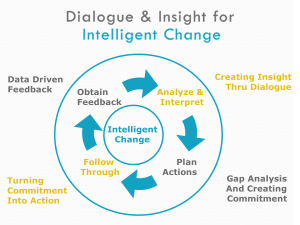
Today’s post focuses on achievers, individualists, strategists and magicians who all share an openness to feedback. Let’s look at each in detail:
4. The achiever wants to win – accomplish the goal, launch the product, land the contract. An achiever looks for a score, a time, or an amount; in other words, feedback that defines achievement. The achiever mindset seeks success within the status quo, like Zaleznik’s “manager.” The achiever plays the feedback game to win.
5. The individualist wants personal growth. Feedback is welcomed because it triggers growth and change. The individualist can return to the mindset of an achiever, going full speed after goals. But the individualist sees self-purpose as more important than the rules of the system. The individualist challenges the status quo, like Zaleznik’s “leader.” The individualist wants to fix the feedback game to make it better.
6/7. The strategist and the magician play the feedback game at a higher level. Instead of a single loop of feedback and action planning, strategists sees interconnected loops with multiple points of contact and causality. When I play Monopoly, I see math skills for my kids to develop, political dynamics for them to perceive and opportunities for them to make SMARTer requests. (At the same time, the individualist in me wants to grow as a parent and the achiever in me wants to win!) The magician sees feedback as integral to all healthy systems, so they create feedback loops, building systems on top of systems.
Bottom line: People think about feedback differently. Know yourself. Know how the people around you react to feedback. Adjust to maximize your influence.
Know yourself. As a leader, know your own mindset in accepting feedback. Which is your typical response to feedback? When you are at your best, what is your response? Your reaction to feedback depends in part on your mental and emotional state.
When I am caught off guard by negative feedback, I tend to react as an expert – defend, deny, and delay. If caught off guard, I try to say “This seems important. Can we talk about it tomorrow?” By delaying (instead of denying or defending), I can receive feedback when I am at my best. Know your triggers for ineffective responses to feedback and work around them.
Bridge to your employees. As a leader, you need to bridge between your mindset and the mindset of your employee. Bridging may involve translation, empathy and a mixture of resolve with patience.
Leaders often give performance feedback expecting the employee to react with an achiever’s mindset. The employee, with an expert mindset, sees the leader as a lesser expert with out-of-date skills and little sense of the actual job. The leader gives achievement-oriented feedback and the expert employee defends, denies or delays. The feedback meeting goes from bad to worse, because manager and employee both believe the other is naive, wrong or worse.
Translate your feedback into your employee’s mindset. In giving feedback to an expert, call on your expertise as a manager. “You know more about your job than me, but I know how management thinks.” If your employee is a diplomat, avoid judgmental words. “Let’s help you fly under the radar in the future.”
Be empathetic. Every mindset is built on all the earlier mindsets. If you are an achiever and your employee is an expert, regress a bit. Remember how to think as an expert and go from there.
Mix resolve and patience. Stick to your guns, but give your employee time to come around. Give continuous feedback so there are no surprises.
Bridge to your boss. As a leader, you and your boss may not share the same feedback mindset. If your boss is at an earlier feedback mindset than you, use translation, empathy, resolve and patience. If your boss is at a later feedback mindset than you, translation and empathy will be tougher because you don’t grasp their mindset yet. Be patient. Resolve to listen and learn so you can grow to think about feedback like they do.
People think differently about feedback. As a leader, bridge these differences with translation, empathy, resolve and patience.
The Problem with Feedback
Allen Slade
Most of us readily accept praise. But leaders can struggle with accepting and acting on constructive criticism. They can balk at negative feedback. Sometimes, it is reasonable to reject feedback because of its low credibility or irrelevance. However, habitually rejecting feedback suggests a deeper pattern – a world view that sees feedback as a problem.
Let’s get personal. How you respond to negative feedback?
Recall the last time you got substantial negative feedback on your work performance or professional relationships from your manager, colleague or close friend at work. How did you react?
1. I saw the feedback as an attack or threat.
2. I saw the feedback as disapproval or judgment.
3. I defended myself, denied the feedback was valid, or delayed receiving the feedback.
4. I accepted the feedback, even though I wanted to do well.
5. I welcomed the feedback.
6. I invited additional feedback.
Suzanne Cook-Greuter lists seven ways to respond to feedback[1]:
Opportunist. Focuses on own immediate needs and opportunities. Values self-protection. Receives feedback as an attack or threat.
Diplomat. Focuses on socially expected behavior. Values approval of others. Sees feedback as disapproval or judgment.
Expert. Focuses on expertise, procedure and efficiency. Values expertise in self and others, but takes feedback personally as an attack on own expertise. Defends, denies, and delays feedback, especially from lesser experts.
Achiever. Focuses on delivery of results. Values effectiveness, goals and success. Accepts feedback if it helps achieve personal goals and improve effectiveness.
Individualist. Focuses on self interacting with the system. Individual purpose and passion are more important than the system. Welcomes feedback as necessary for self-knowledge and to uncover hidden aspects of their own behavior.
Strategist. Focuses on linking theory and practice. Looks for dynamic systems and complex interactions. Invites feedback for self-actualization.
Magician. Focuses on interplay of awareness, thought, action and effects. Values transforming self and others. Views feedback as natural and essential for learning and change.
Today’s post focuses on opportunists, diplomats and experts – those who have response 1, 2 or 3 to negative feedback. Let’s look at each in more detail:
1. An opportunist lives for the moment, seeking passion with little long-term purpose. Since feedback is painful, the opportunist sees it as an attack or threat.
2. The diplomat wants to get along well with others. Feedback is disruptive. The diplomat prefers smoothing over differences.
3. Experts do not like feedback in their area of expertise, because it undermines their expertise. An expert will grudgingly accept feedback from a superior expert, but they often defend themselves by attacking the other person’s expertise.
Because of their problem with feedback, opportunists, diplomats and experts often struggle as leaders. In my experience, leaders must see themselves through the eyes of those they wish to lead. Cook-Greuter found that over 50% of adults have the mindset of an opportunist, diplomat or expert[2]. If half of us struggle in accepting feedback, is it any wonder that there is a shortage of effective leadership?
Bottom line: If you have a problem with feedback, you will struggle as a leader. Shift from seeing feedback as a problem to seeing feedback as a gift.
I am optimistic that anyone with a passion for leadership can develop the purpose necessary to accept feedback. Anyone who wants to help people can develop the norm that feedback is acceptable. Anyone who wants to be the best leader possible can become an expert in seeking and using feedback.
Changing your view of feedback is not easy. It requires substantial growth and development, possibly even a fundamental shift in your world view. Reflection, coaching and practice may help you open yourself to negative feedback. Reflection, such as a journaling, meditation or quiet time, can help you examine yourself and shape your impact as a leader. Leadership coaching helps you create a plan to improve your feedback skills and hold yourself accountable to put that plan in action. Like any other competence, practice accepting feedback is necessary. You need to find the right situations to practice receiving negative feedback. You may want to start in a safe and supportive environment, such as with your coach or in a training class. Then, practice with your trusted circle of advisors in your work situation. Soon, you will want to practice requesting feedback from a wider circle – including people whose expertise or motives are not always clear. Feedback from the bozos and politicians is a gift, because their perspective impacts your leadership as much or more than your circle of trusted advisors.
The problem with feedback is our unwillingness to receive negative feedback. The solution is simple but difficult: See feedback as a gift. If you solve the problem with feedback, if you tackle this simple but difficult change, you will become a better leader and lead a richer life.


